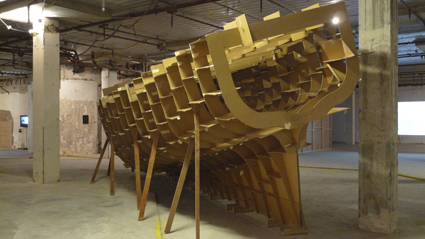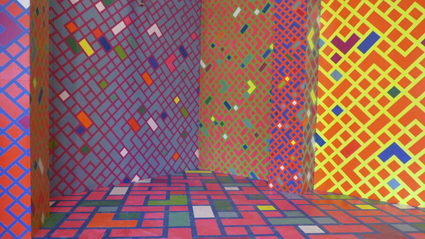sa art: present tense
chris reid: cacsa contemporary 2010: the new new

Jonathon Dady, An Uncertain Vessel (2010)
photos Alan Cruickshank
Jonathon Dady, An Uncertain Vessel (2010)
THE ADELAIDE CONTEMPORARY ART SCENE IS BIG ENOUGH TO SUPPORT A SUBSTANTIAL AND DIVERSE ART COMMUNITY AND SMALL ENOUGH TO STAGE AN EXHIBITION EXEMPLIFYING THAT COMMUNITY’S PRACTICE. CACSA CONTEMPORARY 2010: THE NEW NEW SHOWCASED THE WORK OF 44 ARTISTS ACTIVE IN SA OVER THE LAST DECADE. LOCATED IN 12 SITES, INCLUDING PROMINENT PUBLIC SPACES AND EVEN ON THE SIDE OF A TRAM, NEW NEW CONTINUES CONTEMPORARY ART CENTRE OF SA DIRECTOR ALAN CRUICKSHANK’S INTEREST IN PERIODIC SURVEY EXHIBITIONS.
Cruickshank indicates in the detailed catalogue that the participants were specially selected for the exhibition, which was intended to raise awareness of SA contemporary art and to educate viewers. The opening night at The Gallerie was so well attended that some patrons had to be turned away, attesting to wide interest. This raises the possibility of developing an ongoing exposition and a permanent contemporary art collection. It also raises the question of how artists get media exposure and recognition. New New provided an important opportunity for many artists, partly addressing the perception of CACSA’s preference for international over local art during the decade, though some notable artists were omitted. But it is a significant achievement for CACSA to mount such an extensive exhibition, which was only possible with substantial public and private support.
The work was strategically sited and the seven public works extended the exhibition into prominent locations. The choice of The Gallerie—a gutted, ironically-named, former shopping arcade—as the main location was significant in opening to the public a forgotten corner of the CBD and creating a vibrant atmosphere. But while New New resembled a biennial in scale, it eschewed any unifying curatorial theme. Approximately one third of the artists emerged in SA since 2000, and the work of the established artists generally typified their oeuvres, collectively presenting a Google Earth view of Adelaide’s art. It’s too soon to historicise that decade’s artistic development, but themes and directions are apparent.
New New aggregates the principal strategies of visual art and the forms of visual culture that have emerged since the 1970s—an expanded field of multifarious visual languages, employing traditional and vernacular materials, installation, performance, text, screen media and found objects, and actively engaging the viewer. Identity, contemporary culture and the very nature of the (art) object remain perennial considerations, and full appreciation of New New relies on the viewer’s awareness of recent art history locally as well as internationally.
Most striking was the work greeting viewers at the entrance to The Gallerie, Sam Songailo’s New Sound, an installation that immerses us in a dazzling colour-field, merging neo-Op Art into the fractured architecture to ‘clear’ our heads. Painting’s evolution is apparent in Paul Sloan’s Arise Therefore, which combines painting with found objects (rock band instruments and skeleton) in an installation that also inventively appropriates The Gallerie’s architecture. Anton Hart’s Twins incorporates a found photograph, construction and painting to juxtapose three forms of representation. Painterliness appears in contrasting ways in Christian Lock’s lush, swirling, glossy abstractions Sweet Tooth and The Luxurious Hours of the Duke of Berry, and in Warren Vance’s Voyage d-elimination in which small faux naïf illustrations are mounted on light boxes. Painting meets text and street art in KAB 101’s extensive untitled wall work at The Gallerie and the imagery on the tram.
George Popperwell’s teasingly cryptic but delightfully rewarding Far Away + Once Upon a Time and Bent Bank co-locate Old English texts with commercial packaging. Another intriguing work was Strange Fruit by the conceptual art group Green Candle, a collaboration between John Barbour, Paul Hoban and others. The group approach isn’t new in art, but exciting syntheses are developing between these prominent SA artists.
Adelaide’s established photographers showed the kind of work that has gained them their reputations. Mark Kimber’s lightbox-mounted photos of dioramas in Blyth Street challenge traditional concepts of masculinity. Darren Siwes combines images with installation to reflect on the impact of class and social structure on the developing individual. Ian North’s A Short Walk in the Country eloquently addresses his favoured theme of landscape and the situation of the viewer within it through photographs inscribed like an honour board with the names of great thinkers on landscape and environmental issues. Deborah Paauwe’s Entwined Song continues her concern with loss of innocence; Nici Cumpston’s photographic installation in Rundle Mall movingly documents traces of past Aboriginal occupation of drought-stricken Lake Bonney; and Brenda Croft’s scenes of Australia suggest she is recording it in anticipation of its loss, a kind of nostalgia for the present.
Video is developing in new ways. Made using a phone, Siamak Fallah’s five videos record his spontaneous and intimate interviews with friends and acquaintances. Iranian-trained University of SA masters candidate Nasim Nasr’s moving work, Erasure, shows a chador-clad woman writing on a chador-like form, whereupon the text is erased, referencing the ‘invisibility’ of Iranian women and the issue of cultural incommensurability. Andy Petrusevics’s Buzz! Fizz! Pop! comprises imagery projected onto small panels inside a viewing booth, playfully recreating life as a sideshow. Mark Siebert’s video, Mark Siebert’s South-East Asian Chess Tour, shows the artist playing chess, having declared himself a failed painter, the work inevitably recalling Duchamp’s preoccupation with the game and his withdrawal from painting. Yoko Kajio combines video with performance in Karistirma. And Monte Masi’s videos provide the exhibition’s self-referential element—his rap-style monologues and interviews with artists are both about New New and an element of it.
Environmental awareness emerges strongly but diversely in the work of Angela Valamanesh, Croft, Cumpston, Kajio and North, in Sue Kneebone’s A Broken Party, comprising animal bones on coffee tables, and implicitly in Hossein Valamanesh’s Wishful Thinking that employs the green-powered lighting on the face of a CBD car-park, the Rundle Lantern, to create a striking text.

Sam Songallo, A New Sound
photo Alan Cruickshank
Sam Songallo, A New Sound
My favourites included Songallo’s work for its visual and architectural impact, Jonathon Dady’s An Uncertain Vessel for its grace and conceptual eloquence, and Sally-Ann Rowland’s Monuments, a series of black velvet forms mimicking indoor plants, for their elegant, brooding intensity. Dady’s An Uncertain Vessel is an outline of a boat roughly 10m x 3m x 2m, an iconic form made from cardboard and sitting tilted on wooden supports. It resembles a life-size 3D drawing, exemplifying Dady’s concern with the propositional and his use of discarded packaging to reconsider familiar forms and objects. For me, it suggests a stalled but much needed ark. Equally captivating is Joe Felber’s installation at the CACSA, which juxtaposes competing elements to challenge the viewer’s attention: Playback, El nuevo mundo acústica, in which multiple sound sources are broadcast asynchronously through fixed and swaying loudspeakers, and his video Jumping, Jerking Flesh. And Siamak Fallah’s videos succinctly embody the impact of new communications technologies on human interaction, as well as being the most genuinely new work in the show.
CACSA Contemporary 2010: the New New, Contemporary Art Centre of SA; The Gallerie; Feltspace; the SA School of Art Gallery, University of South Australia; the University of Adelaide; and at various public locations in Adelaide, Oct 29-Nov 21, 2010
RealTime issue #101 Feb-March 2011 pg. 52






